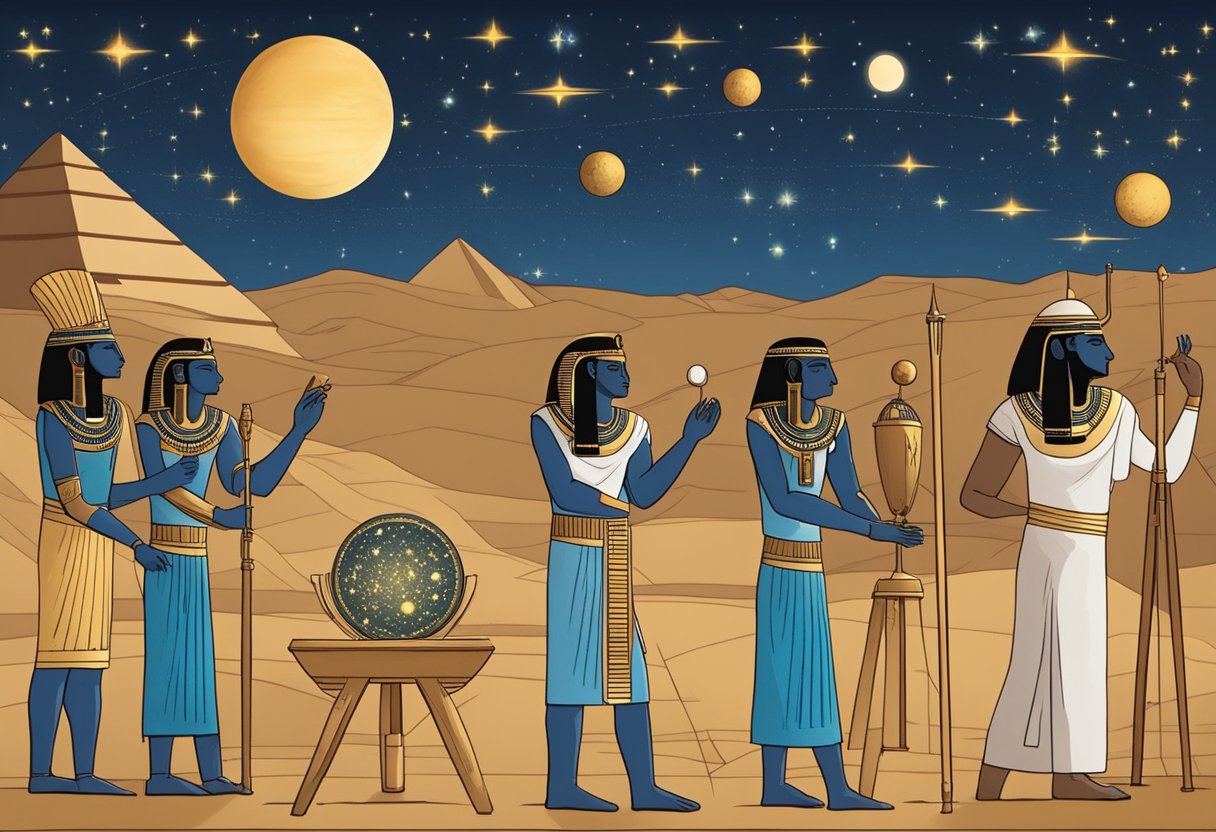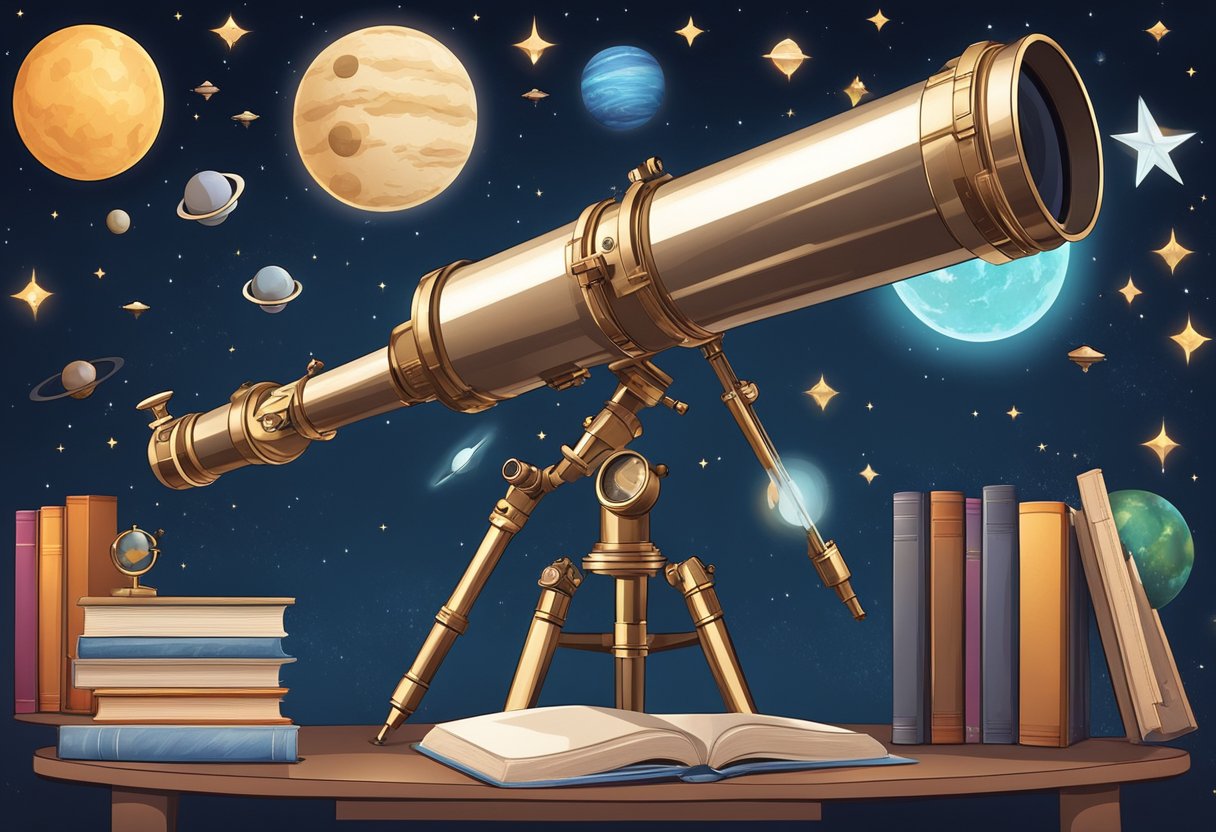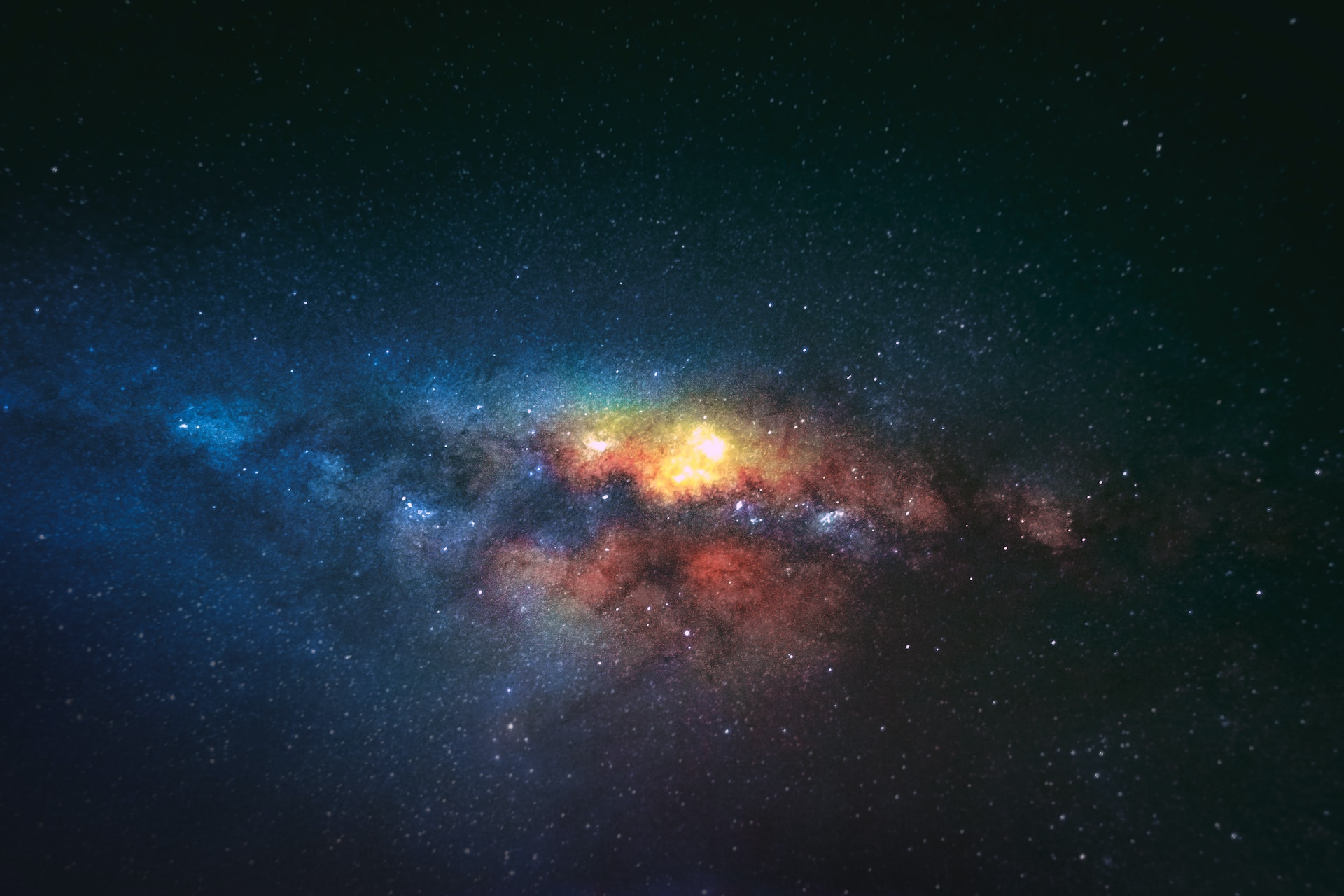The Role of Islamic Scholars in the Golden Age of Astronomy
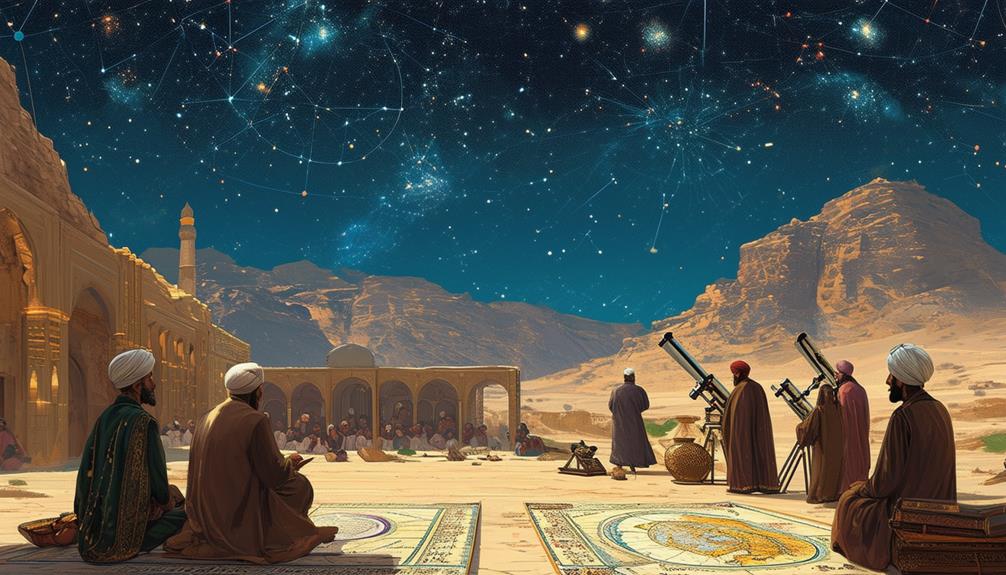
Islamic scholars during the Golden Age of Astronomy made pioneering contributions by not merely accepting the established Ptolemaic models but refining them and introducing innovative tools such as the astrolabe. They integrated classical knowledge with advanced observational methods.
Scholars like Al-Farghani and Ibn al-Haytham played pivotal roles in reshaping astronomy. Their comprehensive work extended beyond mapping the stars; it influenced future generations profoundly.
Among the specific methods and instruments they pioneered were the astrolabe, improved observational techniques, and detailed star catalogs, all of which left a lasting impact on the field.
Expounding and Teaching
Islamic scholars like Al-Farghani and Ibn al-Haytham didn't just study astronomy; they actively taught and disseminated their refined understanding across the Islamic world and Europe. During the Islamic Golden Era, these astronomers played a pivotal role in enhancing and sharing astronomical knowledge.
Al-Farghani, known for his work 'Elements of Astronomy', simplified Ptolemy's 'Almagest' by presenting it with revised values in a more accessible, non-mathematical format. His works circulated widely in the Islamic world and were eventually translated into Latin, becoming essential resources for European scholars studying Ptolemaic astronomy.
Ibn al-Haytham, another significant figure, authored 'Doubts on Ptolemy', where he critiqued and improved upon Ptolemy's models, thus pushing the boundaries of astronomical knowledge even further. These contributions weren't confined to the Islamic world; they were crucial in teaching Europe about advanced astronomical concepts.
Al-Farghani's 'Elements of Astronomy' served as a key educational resource, summarizing Ptolemaic astronomy and facilitating the transfer of knowledge to European scholars. The efforts of Islamic astronomers in compiling, refining, and teaching these astronomical works laid a robust foundation for future advancements in astronomy, bridging cultures, and expanding the collective understanding of the cosmos.
Refining Ptolemaic Models
Building on their efforts in teaching, scholars like Al-Sufi meticulously refined Ptolemaic models by integrating Arabic traditions and expanding the astronomical knowledge base. Islamic scholars didn't merely accept Ptolemy's work at face value; they rigorously re-examined and enhanced it. Al-Sufi's 'Book of the Fixed Stars' exemplifies this approach. He combined Ptolemy's mappings with Arabic traditions, resulting in more precise and extensive models of celestial bodies.
Al-Sufi's illustrations of constellations, viewed from both terrestrial and celestial perspectives, became authoritative, documenting more stars and even early observations of the Andromeda Galaxy. The impact of his work remains evident today as many star names he recorded are still in use. His contributions significantly influenced Ptolemaic astronomy during the Golden Era of Islamic science.
In refining Ptolemy's models, Al-Sufi and his contemporaries enriched the understanding of constellations and celestial bodies. Their work laid the groundwork for later scientific discoveries, demonstrating that Islamic scholars were crucial in advancing astronomy.
Through their detailed observations and integration of diverse traditions, they expanded the boundaries of known astronomical knowledge, benefiting both Islamic and global science.
Disseminating Classical Knowledge
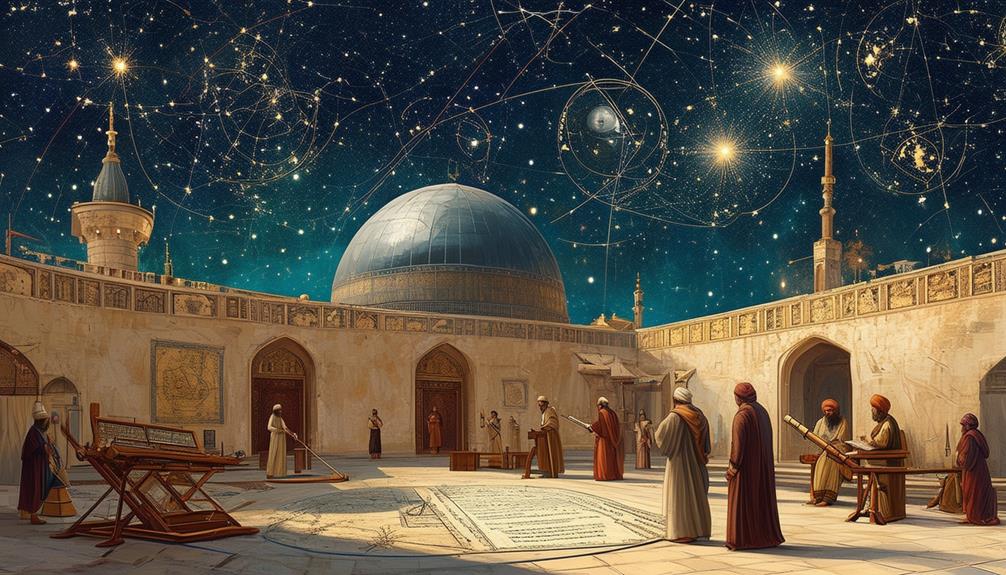
The dissemination of classical knowledge flourished as scholars like Al-Farghani and Abu Ma'shar translated and expanded upon Greek astronomical works, making them accessible and relevant to both Islamic and European audiences. These Islamic scholars played a crucial role in bridging cultural and intellectual divides by spreading classical wisdom.
Al-Farghani's 'Elements of Astronomy' offered a non-mathematical presentation of Ptolemy's Almagest with updated values, making it more understandable and widely circulated. This work influenced European astronomy, demonstrating how the transmission of knowledge can transcend boundaries.
Similarly, Al-Sufi's 'Book of the Fixed Stars' enriched Ptolemy's mappings by incorporating Arabic traditions and documenting additional constellations and stars. His synthesis of classical and Arabic wisdom created a robust astronomical reference that endured through centuries.
Abu Ma'shar's translations empirically connected astrology and astronomy, impacting both Islamic and European thought. Islamic scholars were often portrayed using astronomical tools, highlighting their practical approach to teaching and expanding on existing knowledge. These frontispieces illustrated their essential role in the transmission of knowledge, inspiring future European scholars.
In essence, by spreading classical wisdom, figures like Al-Farghani, Al-Sufi, and Abu Ma'shar ensured that the rich legacy of astronomical inquiry thrived across cultures and epochs.
Mapping the Stars
As scholars like Al-Farghani and Abu Ma'shar disseminated classical knowledge, Al-Sufi meticulously mapped the stars, integrating Ptolemy's data with Arabic traditions. His seminal work, the Book of the Fixed Stars, became foundational in Islamic astronomy. Al-Sufi documented constellations with greater detail and included cultural insights, enhancing Ptolemy's original mapping.
In the Book of the Fixed Stars, Al-Sufi not only chronicled existing constellations but also identified new celestial objects, including the Andromeda Galaxy. His comprehensive work featured detailed illustrations that set the standard for future astronomical charts.
Al-Sufi's influence endures, as many of the star names he recorded remain in use today, underscoring the lasting impact of his contributions to astronomy.
Innovations in Astronomy
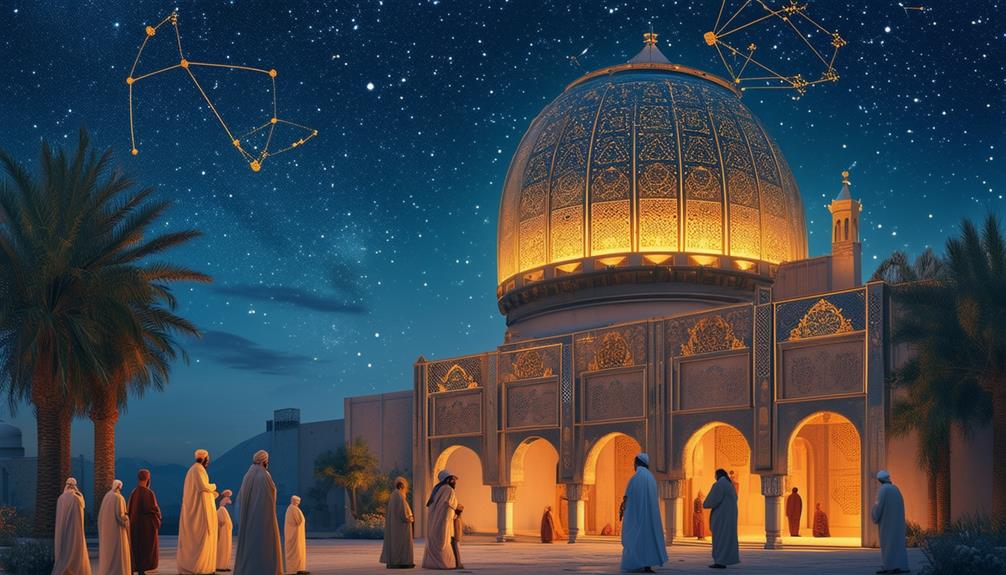
The groundbreaking discoveries of Islamic scholars during the Golden Age of Astronomy significantly reshaped our understanding of the cosmos. Figures like Al-Farabi advanced the field by categorizing astronomy into distinct disciplines, including mathematics, music, and optics, thus laying the groundwork for specialized study.
A notable advancement was the creation of the Tusi Couple by Nasir al-Din al-Tusi, which offered a new explanation for celestial motion and influenced subsequent astronomical research.
Cities like Baghdad and Damascus became pivotal centers of astronomical study, fostering environments where scholars could thrive. These cities emerged as hubs of innovation, as Islamic scholars integrated knowledge from Greek, Sassanid, and Indian sources, thereby enriching their own astronomical practices. This synthesis of influences is evident in the approximately 10,000 surviving manuscripts, showcasing the depth and breadth of Islamic astronomical achievements.
The legacy of Islamic astronomy remains relevant today, with the continued use of Arabic star names and astronomical terms. These innovations not only enhanced our understanding of the cosmos but also cemented the contributions of Islamic scholars in the history of science.
Influence on European Scholars
During the medieval era, Islamic scholars significantly influenced European astronomy through their detailed translations and original contributions. Much of Europe's early astronomical knowledge can be traced back to the Islamic Golden Age, where scholars such as Al-Farghani and Al-Sufi made pivotal advancements.
Al-Farghani's 'Elements of Astronomy' was a cornerstone text, later translated into Latin, providing European scholars with a comprehensive understanding of Ptolemaic astronomy and shaping classical astronomy in the West.
Al-Sufi's 'Book of the Fixed Stars' integrated Ptolemy's work with Arabic traditions, offering detailed illustrations that European astronomers adopted as canonical representations of constellations. These texts weren't mere translations; they included critical observations and refinements that advanced astronomical knowledge.
Translations of Greek texts by scholars such as Abu Mashar facilitated the transmission of Aristotelian ideas to Europe. Islamic scholars preserved and expanded upon these ancient works, ensuring their survival and accessibility.
This transmission of knowledge was crucial in the development of European astronomy, blending Arabic traditions with classical astronomy to create a more comprehensive understanding of the cosmos. The influence of these Islamic scholars was foundational for much of Europe's astronomical advancements.
Mathematical and Observational Methods
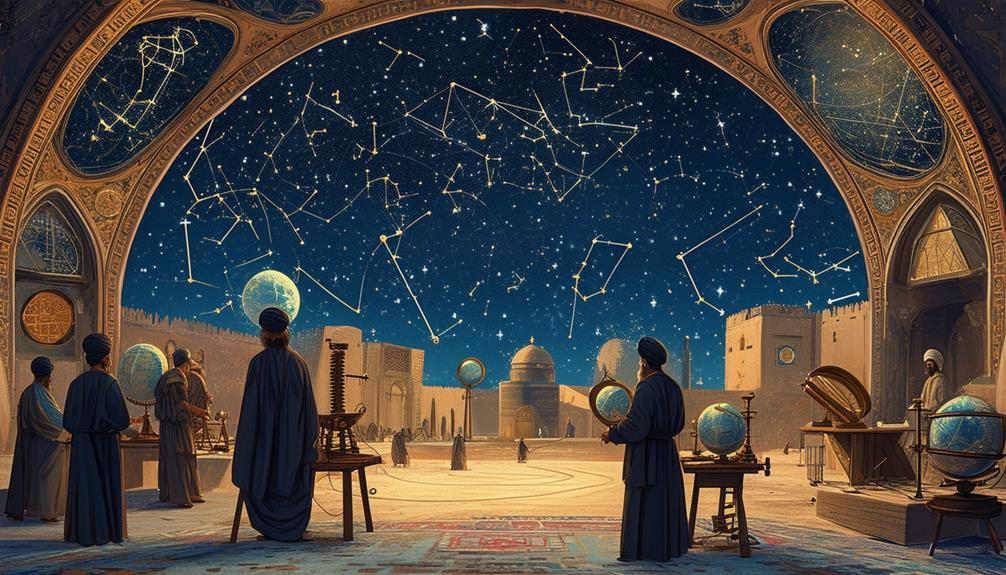
Islamic scholars significantly advanced astronomical studies by developing sophisticated mathematical techniques and constructing state-of-the-art observatories. During the Golden Age of Islam, they revolutionized mathematical astronomy through the use of spherical trigonometry for precise calculations of celestial bodies. This expertise enabled them to distinguish mathematical astronomy from natural philosophy, focusing exclusively on the accurate depiction of celestial motions.
Observatories in cities like Baghdad and locations throughout Iran weren't merely buildings but centers of innovation, equipped with advanced observational tools. Scholars invented devices such as the sextant, which allowed them to measure the angles between stars and planets with exceptional accuracy.
Al-Farabi made significant contributions by integrating mathematics, music, and optics into the study of astronomy, providing a detailed framework for understanding celestial phenomena. This mathematical approach allowed for more precise descriptions and predictions of astronomical events.
These advanced methods laid the groundwork for future astronomical discoveries. By emphasizing observational precision and mathematical rigor, Islamic scholars ensured their work would continue to influence generations of astronomers long after the Golden Age.
Their legacy is a testament to the power of merging observational diligence with mathematical innovation.
Development of Astronomical Instruments
Islamic scholars made significant advancements in the development of astronomical instruments. They created tools such as the astrolabe and observational sextants for precise measurements.
They also developed the Tusi Couple to explain celestial motion. These innovations greatly enhanced the accuracy of astronomical studies.
Observational Sextants and Astrolabes
Astrolabes and sextants revolutionized celestial observations long before the telescope, showcasing the ingenuity of Islamic astronomers. These instruments were pivotal in advancing Islamic astronomy by providing accurate measurements and enhancing observational capabilities.
Sextants allowed astronomers to measure celestial altitudes precisely, enabling them to determine the positions of stars and planets, which was essential for celestial navigation. Astrolabes, perfected by scholars like Mariam al-Astrulabi, were indispensable for calculating celestial altitudes and timekeeping. These devices empowered astronomers to chart the heavens with remarkable accuracy.
Islamic astronomers' expertise in creating and using astrolabes and sextants was evident in their ability to:
- Perform precise celestial observations.
- Accurately calculate time based on stellar positions.
- Navigate using stars and celestial bodies.
- Enhance their overall observational capabilities.
The extensive use of astrolabes in Islamic astronomy for centuries highlights their significance. These instruments not only mapped the skies but also played a vital role in daily life, influencing navigation, prayer times, and agricultural planning.
The legacy of astrolabes and sextants underscores the profound impact of Islamic scholars on the evolution of astronomy.
Tusi Couple Mechanism
Nasir al-Din al-Tusi's creation of the Tusi Couple marked a significant advancement in the modeling of celestial motion, offering a more precise alternative to Ptolemy's equant system.
The Tusi Couple mechanism involves a smaller circle rotating inside a larger circle, which allows for a more accurate depiction of planetary paths. This geometric construction resolved mathematical inconsistencies in Ptolemy's system, providing a clearer and more precise model for celestial movements.
By integrating the Tusi Couple into their astronomical models, scholars could predict planetary paths with greater accuracy. This innovation was crucial not only during the Islamic Golden Age but also influenced later astronomers like Copernicus. Al-Tusi's contributions to celestial mechanics laid the groundwork for the evolution of modern astronomy.
The Tusi Couple mechanism transformed the understanding of planetary motion and stands as a significant milestone in the history of astronomy. It highlighted the importance of precise geometric constructions in astronomical studies and showcased the substantial contributions of Islamic scholars to celestial mechanics.
The Tusi Couple remains a testament to the innovative spirit of the Islamic Golden Age.
Mathematical Precision Tools
Islamic scholars significantly advanced the field of astronomy through the development of sophisticated mathematical precision tools. Notable among these were the astrolabe, the quadrant, and the sine quadrant, each contributing to more accurate celestial measurements and timekeeping.
Here are some key innovations:
- Astrolabe: A versatile instrument used for measuring celestial heights and determining time, allowing scholars to pinpoint the positions of stars and planets with great accuracy.
- Quadrant: A device that facilitated the measurement of the altitude of celestial bodies and also served as a timekeeping tool.
- Sine Quadrant: Introduced by Al-Khwarizmi, this tool greatly enhanced the precision of astronomical calculations.
These advanced astronomical instruments collectively transformed the accuracy and sophistication of astronomical observations during the Golden Era, enabling Islamic scholars to make significant strides in the field.
Cultural Context and Impact
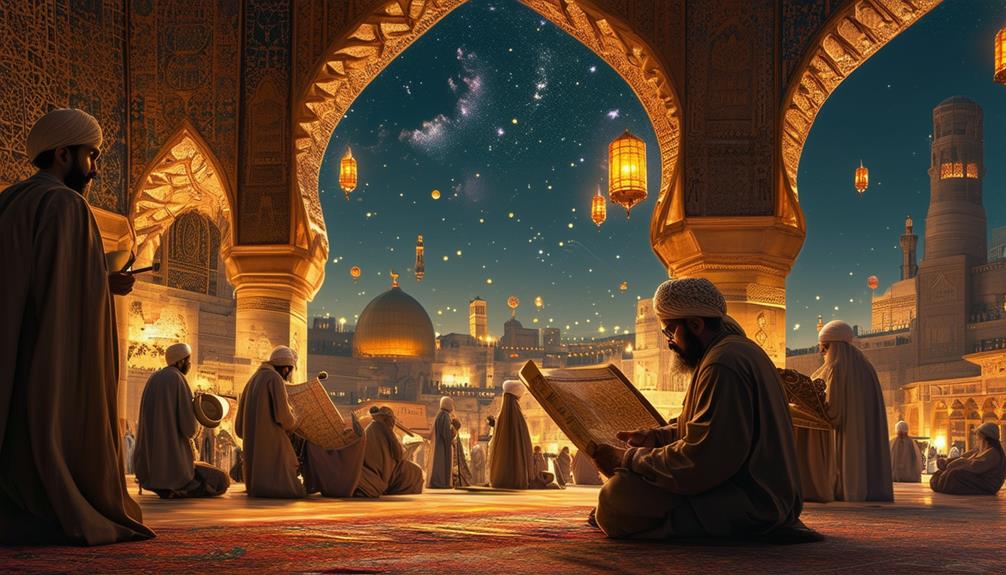
Islamic scholars not only preserved ancient knowledge but also translated and expanded upon it, creating a comprehensive body of astronomical understanding. The dual role of astrology as both a science and a cultural practice influenced their work, shaping their observations and interpretations of the cosmos. These contributions laid the foundation for future astronomical advancements in Europe and other parts of the world.
Translating Ancient Knowledge
How did the translation of ancient texts into Arabic during the Islamic Golden Age revolutionize the field of astronomy?
Islamic scholars translated pivotal works like Ptolemy's Almagest, along with other Greek, Indian, and Persian astronomical texts, into Arabic. This monumental task didn't just preserve ancient knowledge; it propelled astronomy to new heights during this period.
By translating these classical astronomical texts, Islamic scholars created a bridge between ancient civilizations and future generations. The intellectual curiosity and openness of the Islamic world allowed these translations to thrive, leading scholars to not only translate but also refine and expand upon the knowledge, significantly advancing the field of astronomy.
- Ptolemy's Almagest was revitalized and made more accessible.
- Arabic names for stars and astronomical terms, derived from these translations, are still in use today.
- The meticulous work of these scholars influenced the development of astronomy in the West.
- Approximately 10,000 manuscripts on Islamic astronomy exist, underscoring the extensive impact.
In essence, the translation endeavors during the Golden Age were transformative acts that reshaped the trajectory of astronomical science for centuries to come.
Astrology's Dual Role
With the translation of ancient astronomical texts, astrology in the medieval Islamic world emerged as both a scientific study and a significant cultural practice. Islamic scholars applied their astronomical knowledge to predict celestial influences on earthly events, intertwining the study of the stars with daily life.
Astrologers in bazaars and royal courts used tools like astrolabes to provide services, crafting predictions based on planetary characteristics and symbolic representations. These practices sparked debates regarding their scientific validity and ethical implications. Critics, including theologians and philosophers, questioned the alignment of astrology with Islamic principles.
| Aspect | Details |
|---|---|
| Scientific Endeavor | Utilized astronomy to predict celestial influences |
| Cultural Practice | Astrological services in bazaars and royal courts |
| Debates and Criticism | Theological and philosophical challenges on ethical grounds |
Astrological writings often imbued planets with symbolic meanings, suggesting talismanic powers in their artistic depictions. Zodiac symbols, many derived from Greek traditions, adorned various objects and were believed to confer protection or luck. This dual role of astrology—scientific and cultural—highlights its complex place in the medieval Islamic world, balancing practical applications with rich cultural symbolism.
Legacy of Islamic Astronomers
The legacy of Islamic astronomers is evident in the substantial advancements they made, which continue to influence modern astronomy. During the Golden Age of Islam, astronomers like Al-Farghani, Al-Sufi, and Abu Mashar made significant contributions to our understanding of the universe. Their work extended beyond observations and calculations; they were crucial in transmitting knowledge across cultures.
By translating and expanding upon classical texts, they laid the foundation for future astronomical discoveries. European scholars greatly benefited from these contributions. The translation of Islamic works into Latin opened new avenues for astronomical research in medieval Europe, shaping the course of Western science. To fully appreciate this legacy, one must consider the cultural context in which these scholars operated, as they were part of a vibrant intellectual tradition that valued systematic study of the natural world.
Key points to consider:
- Islamic astronomers preserved and expanded upon Greek and Indian astronomical knowledge.
- Their careful observations led to improvements in astronomical instruments.
- They enhanced the accuracy of celestial maps and star catalogs.
- Their works influenced notable European scholars like Copernicus and Kepler.
The historical understanding of the cosmos has been profoundly shaped by the contributions of these pioneering astronomers.
Conclusion
Islamic scholars played a pivotal role in the Golden Age of Astronomy. They not only refined Ptolemaic models but also invented new astronomical instruments and mathematical methods, enhancing the precision of star mapping.
By integrating classical knowledge with innovative perspectives, they laid the groundwork for future astronomical discoveries. Their contributions continue to influence contemporary astronomy, underscoring their enduring legacy.

